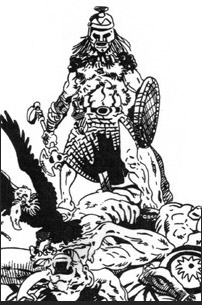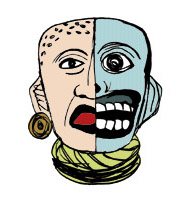This is not a proper bestiary. We are concerned mostly with creatures which could represent a danger to your protagonist.
Wolves would be of the smaller variety now common to Spain and Central Asia, not the large timber wolf of North America, but closer in size to the American red wolf. This creature would only be common in the mountainous interior along the forested mountains and up into Thrace and the wild lands beyond.
Boar would be common in Thrace, where a deity associated with boars was worshipped. In earlier Homeric [about 100 years before our period] times pigs were raised in abundance. They would now be uncommon animals in the deforested seaside communities, but remain common in the hinterlands, particularly in Epirus and around Dodona. Pigs were allowed to graze freely on acorns in regions with stands of oak. This of course resulted in a feral boar population such as currently seen in the Southern United States. This is a nasty animal that will gore a person to death with its tusks and then eat the human flesh and entrails. Even domestic pigs have been known to eat people.
The Auroch, or wild European cattle that roamed the forests and grasslands of primeval Europe might be found in the hinterlands, but with decreasing frequency. The last mention of the Auroch in Thessaly was around 390 B.C., so by 590 they were already well on the decline. There are some mosaic illustrations from the Roman period featuring auroch hunting in the arena, as well as fresco paintings from earlier Minoan Crete, where these large horned beasts were leaped by acrobats, forming the basis for the Minotaur legend. By this date however, there would be no aurochs surviving on Crete of near other major population centers. The auroch is a huge beast with a massive sweep of horns that favored wet grasslands in summer and would move into forests in the winter to feed on acorns and twigs. It is easily the most dangerous animal in Europe, with the male much larger than the female. Prehistoric cave paintings feature auroch’s prominently. The last auroch was a cow who died of natural causes in a Polish forest in 1627, one of the earliest attempts at animal conservation sadly failing.
The Lion of ancient Europe was similar to the African beast in size with males ranging between 400 and 450 pounds, but closer in appearance to the smaller Asiatic lion, though without the lateral and abdominal manes. These lions were present in northern and western Greece during the period under discussion, and would be extinct by A.D. 70. The lion was regarded as a creature with supernatural aspects. They were hunted either by teams of spearman, with a shield bearer in the lead, or by loan heroes or kings, with Alexander nearly being killed by an Asiatic lion, and the hero Polydamus supposedly having strangled one, though I think he beat it to death with a massive club. Polydamus was a giant man of pro-wrestling proportions who killed 3 Persian warriors with his naked hands in a 3-on-1 fight in about 400 B.C.
Dolphins were sacred to Apollo and there is one credible account of a scholar being dumped overboard by pirates and being spirited to shore at or near Corinth by a dolphin.
Smarayes, a brawling goblin, is just too good an idea to leave out. Perhaps we can write him into a story as a member of a remnant tribe of Neanderthals skulking in a misty hinterland location.











